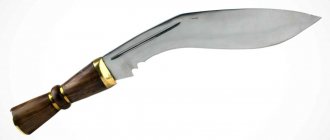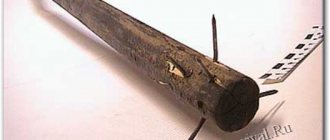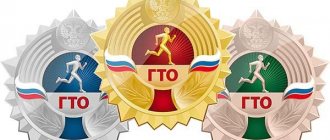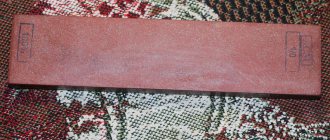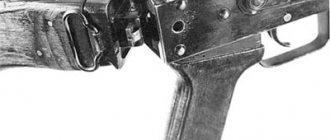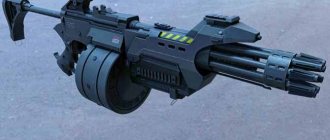The baton is one of the most ancient types of impact weapons. Having provided an invaluable service to humanity in the struggle for survival at the early stage of its development, having gone through peasant wars, batons are now used by the police and law enforcement forces. Police officers and security guards carry batons. Batons are used for the purposes of non-lethal self-defense, accompanying troublemakers, and when dispersing crowds during mass riots. With the help of batons, blows, blocks, painful and choking techniques are used.
Design
Depending on the model of the baton, its design, material, weight, length and thickness may vary. Previously, police batons were made of durable wood, but now they are most often made of rubber and polymer synthetic material, less often of plastic, and even less often of metal.
Rubber batons can be flexible or inflexible; the latter can have a metal core rod or a tube through which steel balls roll. Metal batons are most often telescopic, of varying flexibility, from 20 cm in length when folded to 60 cm in a combat position (they can be extended manually or automatically, under the action of a spring).
In many Western countries, a baton is used that has a metal rod surrounded by rubber. It ends in a flexible section of rubber or leather (sometimes with lead). With the help of this weapon, as a rule, they deliver stunning blows.
Finally, law enforcement agencies in a number of Western countries are armed with special equipment in the form of police batons, which, when the trigger button is pressed, “shoot” a charge of irritant[1]. There are also models of batons with a built-in stun gun[2].
Most modern batons usually have a dedicated handle and a belt loop to keep the baton from slipping out of the owner's hands. The handle is usually designed for one hand.
Advantages and disadvantages
The disadvantages of police batons are a direct extension of their advantages.
The relatively low power of the baton as a hand-held weapon with shock-crushing action is both its disadvantage and its advantage.
This is a disadvantage because this weapon does not have much impact. Doesn't kill a person. Usually its use does not even cause a person to lose consciousness. It causes relatively little damage to the health of the attacker. Yes, this is a drawback. The gun is much more effective.
But at the same time, low power is a very important advantage of the baton. She leaves the intruder alive
Does not deprive him of his ability to work. The purpose of this weapon is not to kill a person, but to force him to change his behavior: leave an unauthorized meeting, stop a domestic fight, obey the order of a government official.
And the baton copes with its tasks very well.
Author of the article:
Stolts Konstantin
Engineer. PhD.
History of application
Standard models of police batons appeared in the 19th century, with the advent of national police in European countries (having a centralized system of supply and training of personnel).
In the police of foreign countries
The English police use short (about 460 mm long) straight batons made of hardwood ( billy club
) appeared in 1848, during the Victorian era. Since the 1930s, they began to be made from rubber.
lathi) were adopted for the colonial police
).
The Japanese police, created in 1874, are armed with a straight wooden baton called " keijo"
"125 cm long arrived in the late 1930s (previously, police were armed with short swords and unsharpened daggers "jutte"), a straight wooden baton "
keibo
" 50 cm long - in 1946, and a telescopic baton "
tokushi keibo
" - in 1961[3].
In the United States, straight wooden batons with a length of 30 to 65 cm were initially used, which looked like a smaller copy of a baseball bat, but in the 1960s, Los Angeles police officer Robert Koga developed a new version of the straight wooden baton - with a ring for attaching to the belt and a rounded end ( in order to reduce the risk of injury with tissue dissection during chopping blows). The Koga Stick was supplied to many US police departments[4].
In the 1960s-1970s, batons in the form of tonfas were adopted by the police of a number of Western countries. For the first time, batons of this type were used by French police during the suppression of student protests in 1968, later “tonfas” (under the name T-baton
) appeared in the US police, but they became widespread after a standardized model was developed in 1972 - the PR-24 “Prosecutor”[4].
In Russian and Soviet law enforcement structures
On May 20, 1881, the Minister of Internal Affairs of the Russian Empire sent a report to the emperor with a request to arm the lower ranks of the St. Petersburg police with “wooden clubs” instead of dragoon-style sabers[5]. Despite the emperor’s refusal, police “wooden clubs” that had already been made earlier were issued to some police officers.
In 1941-1944, in the occupied territory of the USSR, wooden and rubber batons were in service with camp and auxiliary police officers (policemen)[6].
In the USSR, the question of arming the police with rubber truncheons was raised more than once, but only in July 1962, in accordance with the order of the Minister of Internal Affairs of the RSFSR “On the adoption of rubber truncheons and handcuffs by the police,” they entered service. In 1966, the order of the Minister of Public Order of the RSFSR established the procedure for their wearing and use: “It is allowed to carry a rubber stick naked in the hand, as well as on a belt on the left side... Rubber sticks should be introduced only with the permission of the Ministry of Defense of the RSFSR at the request of the ministers of the PLO of the autonomous republics , heads of departments of the PLO regional executive committees, agreed with the relevant regional committees, regional party committees.” It was recommended to resort to its help to “suppress the violence and disorder of hooligans and other criminals, as well as in relation to violators of public order who refuse to comply with the legal demands of police officers, to repel attacks on police officers or vigilantes, officials, state, public organizations and citizens” . However, it was strictly forbidden to strike the face and head and use batons against women, children, the elderly and disabled, as well as in police premises.[7]
The standard “Soviet” police baton PR-73 has a length of 65-70 cm (put into service in 1973). Straight rubber stick “PR-73M” (PR-73 Modernized), designed to repel attacks by offenders or suppress their disobedience. The use of a rubber stick does not cause life-threatening injuries only in cases where it is used in accordance with the requirements established by law.
There were also its modifications: Pr-UZM (TU ANVYA6 354.031), Pr-89 (TU ANVYA6 354.032) and Pr-90 (TU ANVYA6 354.038)[8].
In the 90s, batons of a more advanced design appeared, which were called PUS-2 “Argument”. The “argument” has a transverse handle in the front part, which is convenient for holding it with an emphasis on the elbow (for delivering a backhand strike), as well as for blocking the opponent by using a choke hold or a painful hold. It can also catch something, for example, an opponent’s neck, a backpack strap, or a machine gun belt.
The handle can be metallized (in a reinforced version) and has notches. This type of baton was initially used only by riot police, but currently most police officers are equipped with them. Also purchased by citizens for self-defense or for training.
During the years of perestroika, the rubber baton acquired the nickname “democratizer” or “lever of democracy.”
Technique for working with tonfa
Tonfa is a weapon that allows a fighter to use a very wide range of strikes, blocks, grabs and other techniques during a fight. Usually the tonfa is taken by the handle, so that the long end of the stick is parallel to the forearm, and the short end comes out from behind the fist.
The long end of the baton allows you to parry any enemy blows delivered by both limbs and melee weapons. In this case, you can deliver powerful swinging or pushing blows with your forearm. The latter are the most effective; they are applied with a short part of the tonfa, which is, as it were, an extension of the fighter’s fist. However, the long part of the weapon is also suitable for them, which can be thrown forward along with the elbow. Tonfas are often used in pairs.
By rotating the weapon around the handle held in the palm, you can carry out a whole series of powerful swing strikes.
A special technique for working with the new baton was developed for American law enforcement officers. The areas of the human body that can be affected by tonfa have received their own classification. For example, blows to the limbs are very effective and allow you to immobilize a suspect, but at the same time they cause temporary and minimal damage and simply incapacitate the person for a while. And the face, back and chest are areas where impacts can lead to serious injury, so hitting them is recommended only in extreme cases.
Currently, there are a large number of different martial arts schools in the world that teach tonfa. They are very different. Some of them are closer to the Japanese and Okinawan classics; in such schools they carefully study and practice various kata and receive belts of different colors. Other schools are more focused on modernity and the practical side of using these weapons.
Author of the article:
Egorov Dmitry
I am interested in military history, military equipment, weapons and other issues related to the army. I love the written word in all its forms.
Legal status
| : Incorrect or missing image | This section is missing references to information sources. Information must be verifiable, otherwise it may be questioned and deleted. You may edit this article to include links to authoritative sources. This mark is set June 5, 2013 . |
K: Wikipedia: Articles without sources (type: not specified)
Since police batons and sticks are special equipment, in many countries of the world [ which ones?
] (in accordance with the law) their commercial sale and free circulation is limited or prohibited. In Russia, the legal aspect of the acquisition of a rubber police baton by citizens is not regulated by law[9]. The RDU 50 baton has been certified and can be sold and carried freely as a self-defense weapon (Certificate of Conformity POCC RU. СЗ09.Н01979 dated 08/21/2003). At the same time, other models of batons are sold freely in some places, in others only upon presentation of the ID of a police officer or private security guard, which store employees cannot explain. Since they are formally considered special equipment, an ordinary citizen may have problems with self-defense using them.
In what situations is it used?
The PR-73 rubber stick is used:
In prisons and pre-trial detention centers. In order to prevent an attack, employees of the penitentiary system have the right to use this special means in relation to suspects, accused and convicted persons. Hitting with a rubber truncheon is legalized during mass riots and group violations of the regime by persons under investigation and convicts. The use of special means is allowed in cases of disobedience to correctional officers and attempts to escape.
- To prevent escape when escorting a detainee, suspect or convicted person.
- When the hostages are released.
- During the dispersal of protesters at unauthorized rallies.
- During the assault by law enforcement special forces on buildings and vehicles.
The advantage of rubber sticks is the absence of serious injuries on the human body after using this special equipment. This is possible in cases where the use of PR meets all the requirements established by law.
Interesting Facts
- In the US police, a tradition has been preserved since the 19th century: a policeman hired for service, before his first appearance on duty, is given a baton with the words “this is for you instead of brains” [4]
- The police baton is repeatedly mentioned in Nikolai Nosov’s novel “Dunno on the Moon”:
- How dare you not give the money, you bastard? - the policeman yelled, placing his hands on his hips and sticking out his fat belly. “Firstly, I’m not a brute,” Dunno answered with dignity, “and secondly, I don’t have any money.” I didn’t take any money from him and didn’t even see him.
- Did you see this? - asked the policeman and thrust a rubber baton under Dunno’s nose.
Dunno involuntarily threw his head back.
-What do you think this is? - asked the policeman. - Come on, smell it.
Dunno carefully sniffed the tip of the baton.
“Must be a rubber stick,” he muttered.
- “Rubber stick”! - the policeman mimicked. - So it’s clear that you’re an ass! This is an advanced rubber baton with an electrical contact. Abbreviated as URDEK. Come on, stand still! - he commanded. - R-r-hands at the seams! And no r-talk!
Dunno mechanically raised his head and stretched his arms at his sides. The policeman poked him in the forehead with the tip of his baton. There was a crash. Dunno was hit with an electric current, so much so that sparks flew from his eyes, his head began to buzz, and he staggered, unable to stand on his feet. Grabbing Dunno by the collar, the policeman began to rummage through his pockets and, finding nothing in them, dragged him through the crowd that began to gather around.
Strikes ahead. In what cases are they used?
Moments when a preemptive strike is most effective:
During the attack
The attacker concentrates all his attention on his own action and at this time is not ready to attack the guard. At the moment when the attacker takes a knife, stick, broken bottle or other bladed weapon from his pocket. During the swing... Before launching pre-emptive strikes, guards can negotiate, distract with their gaze and perform other actions in order to lull the vigilance of the criminal
A pre-emptive strike is first applied to the hand holding the weapon in order to knock it out. The guards' instructions recommend a blow to immobilize a hand and temporarily incapacitate it as acceptable.
Before launching preemptive strikes, guards can negotiate, distract with their gaze, and perform other actions in order to lull the vigilance of the criminal. A pre-emptive strike is first applied to the hand holding the weapon in order to knock it out. The guards' instructions recommend a blow to immobilize a hand and temporarily disable it as an acceptable blow.
The official work of law enforcement officers and workers in the security business involves frequent clashes with the criminal element. The introduction of PR into the equipment of police and security guards, as well as training to increase the efficiency of using this special equipment, provides law enforcement officers with the opportunity to get out of conflict situations without casualties.
Notes
- Liskin Yu. Police baton in Russia // magazine “At a combat post” No. 5-6, 1993
- I. Petrov. Washington Club Bearers // “New Time”, No. 41 of 10/08/1982, p. 17
- Anatoly Fomin. [www.bratishka.ru/archiv/2010/9/2010_9_9.php Arsenal: impact weapons] // “Brother” magazine, September 2010
- ↑ 123
Alex Levitas. “This is for you instead of brains...” // Master Gun magazine, No. 65, 2002. pp. 82-85 - [wap.neklinkovoe.forum24.ru/?1-2-0-00000011-000-0-0 Report of the Minister of Internal Affairs “On arming the lower ranks of the St. Petersburg city police with wooden clubs”]
- D. A. Zhukov. I. I. Kovtun. Russian police. M., "Veche", 2010. p.194-197
- [psj.ru/saver_people/detail.php?ID=64716 V. Prasolov. Rubber stick: practice of use in private security activities // Security Activities magazine, September 2010]
- [www.consultant.ru/document/cons_doc_LAW_106912/8cbc0a4fbb703b21bacc32ba1fe5c17478e74775/ Decree of the Government of the Russian Federation of November 12, 2010 N 894 (as amended on November 24, 2015) “On special means and firearms used by the departmental security of the State cor...]
- [i2.guns.ru/forums/icons/forum_pictures/003153/3153982.jpg Official response from the Ministry of Internal Affairs of the Russian Federation].
Excerpt characterizing the police baton
Ilya Andreich approved this proposal, immediately understanding its reasonableness. If the old man relents, then all the better it will be to come to him in Moscow or Bald Mountains, later; if not, then it will be possible to get married against his will only in Otradnoye. “And the true truth,” he said. “I regret that I went to him and took her,” said the old count. - No, why regret it? Having been here, it was impossible not to pay respects. Well, if he doesn’t want to, that’s his business,” said Marya Dmitrievna, looking for something in her reticule. - Yes, and the dowry is ready, what else do you have to wait for? and what’s not ready, I’ll send it to you. Although I feel sorry for you, it’s better to go with God. “Having found what she was looking for in the reticule, she handed it to Natasha. It was a letter from Princess Marya. - He writes to you. How she suffers, poor thing! She is afraid that you will think that she does not love you. “Yes, she doesn’t love me,” said Natasha. “Nonsense, don’t talk,” Marya Dmitrievna shouted. - I won’t trust anyone; “I know that he doesn’t love me,” Natasha said boldly, taking the letter, and her face expressed dry and angry determination, which made Marya Dmitrievna look at her more closely and frown. “Don’t answer like that, mother,” she said. – What I say is true. Write an answer. Natasha did not answer and went to her room to read Princess Marya’s letter. Princess Marya wrote that she was in despair over the misunderstanding that had occurred between them. Whatever her father’s feelings, Princess Marya wrote, she asked Natasha to believe that she could not help but love her as the one chosen by her brother, for whose happiness she was ready to sacrifice everything. “However,” she wrote, “don’t think that my father was ill-disposed towards you. He is a sick and old man who needs to be excused; but he is kind, generous and will love the one who will make his son happy.” Princess Marya further asked that Natasha set a time when she could see her again. After reading the letter, Natasha sat down at the desk to write a response: “Chere princesse,” [Dear princess], she wrote quickly, mechanically and stopped. “What could she write next after everything that happened yesterday? Yes, yes, all this happened, and now everything is different,” she thought, sitting over the letter she had begun. “Should I refuse him? Is it really necessary? This is terrible!”... And in order not to think these terrible thoughts, she went to Sonya and together with her began to sort out the patterns. After dinner, Natasha went to her room and again took Princess Marya’s letter. - “Is it really all over? she thought. Did all this really happen so quickly and destroy everything that was before”! She recalled with all her former strength her love for Prince Andrei and at the same time felt that she loved Kuragin. She vividly imagined herself as the wife of Prince Andrei, imagined the picture of happiness with him repeated so many times in her imagination, and at the same time, flushed with excitement, imagined all the details of her yesterday's meeting with Anatole. “Why couldn’t it be together? sometimes, in complete eclipse, she thought. Then only I would be completely happy, but now I have to choose and without either of both I cannot be happy. One thing, she thought, to say what was meant to Prince Andrei or to hide it is equally impossible. And nothing is spoiled with this. But is it really possible to part forever with this happiness of Prince Andrei’s love, which I lived for so long?” “Young lady,” the girl said in a whisper with a mysterious look, entering the room. – One person told me to tell it. The girl handed over the letter. “Only for Christ’s sake,” the girl was still saying when Natasha, without thinking, broke the seal with a mechanical movement and read Anatole’s love letter, of which she, without understanding a word, understood only one thing - that this letter was from him, from that man, whom she loves. “Yes, she loves, otherwise how could what happened happen? Could there be a love letter from him in her hand?” With shaking hands, Natasha held this passionate, love letter, composed for Anatoly by Dolokhov, and, reading it, found in it echoes of everything that it seemed to her that she herself felt. “Since last night, my fate has been decided: to be loved by you or to die. I have no other choice,” the letter began. Then he wrote that he knew that her relatives would not give her to him, Anatoly, that there were secret reasons for this that he alone could reveal to her, but that if she loved him, then she should say this word yes, and no human forces will not interfere with their bliss. Love will conquer everything. He will kidnap and take her to the ends of the world. “Yes, yes, I love him!” thought Natasha, re-reading the letter for the twentieth time and looking for some special deep meaning in every word. That evening Marya Dmitrievna went to the Arkharovs and invited the young ladies to go with her. Natasha stayed at home under the pretext of a headache. Returning late in the evening, Sonya entered Natasha's room and, to her surprise, found her not undressed, sleeping on the sofa. On the table next to her lay an open letter from Anatole. Sonya took the letter and began to read it. She read and looked at the sleeping Natasha, looking on her face for an explanation of what she was reading, but did not find it. The face was quiet, meek and happy. Clutching her chest so as not to suffocate, Sonya, pale and trembling with fear and excitement, sat down on a chair and burst into tears. “How did I not see anything? How could it have gone this far? Has she really stopped loving Prince Andrei? And how could she let Kuragin do this? He is a deceiver and a villain, that much is clear. What will happen to Nicolas, sweet, noble Nicolas, when he finds out about this? So this is what her excited, determined and unnatural face meant the third day, both yesterday and today, thought Sonya; but it cannot be that she loves him! Probably, not knowing from whom, she opened this letter. She's probably offended. She can't do this! Sonya wiped away her tears and walked up to Natasha, again peering into her face. - Natasha! – she said barely audible. Natasha woke up and saw Sonya. - Oh, she’s back? And with the determination and tenderness that happens in moments of awakening, she hugged her friend, but noticing the embarrassment on Sonya’s face, Natasha’s face expressed embarrassment and suspicion. - Sonya, have you read the letter? - she said. “Yes,” Sonya said quietly. Natasha smiled enthusiastically. - No, Sonya, I can’t do it anymore! - she said. “I can’t hide it from you anymore.” You know, we love each other!... Sonya, my dear, he writes... Sonya... Sonya, as if not believing her ears, looked at Natasha with all her eyes. - And Bolkonsky? - she said. - Oh, Sonya, oh, if only you could know how happy I am! - Natasha said. – You don’t know what love is... – But, Natasha, is it really all over? Natasha looked at Sonya with big, open eyes, as if not understanding her question. - Well, are you refusing Prince Andrei? - said Sonya. “Oh, you don’t understand anything, don’t talk nonsense, just listen,” Natasha said with instant annoyance. “No, I can’t believe it,” Sonya repeated. - I don't understand. How did you love one person for a whole year and suddenly... After all, you only saw him three times. Natasha, I don’t believe you, you’re being naughty. In three days, forget everything and so... “Three days,” said Natasha. “It seems to me that I have loved him for a hundred years.” It seems to me that I have never loved anyone before him. You can't understand this. Sonya, wait, sit here. – Natasha hugged and kissed her. “They told me that this happens and you heard correctly, but now I have only experienced this love.” It's not what it used to be. As soon as I saw him, I felt that he was my master, and I was his slave, and that I could not help but love him. Yes, slave! Whatever he tells me, I will do. You don't understand this. What should I do? What should I do, Sonya? - Natasha said with a happy and frightened face. “But think about what you’re doing,” said Sonya, “I can’t leave it like that.” These secret letters... How could you let him do this? - she said with horror and disgust, which she could hardly hide. “I told you,” Natasha answered, “that I have no will, how can you not understand this: I love him!” “Then I won’t let this happen, I’ll tell you,” Sonya screamed with tears breaking through. “What are you doing, for God’s sake... If you tell me, you are my enemy,” Natasha spoke. - You want my misfortune, you want us to be separated... Seeing this fear of Natasha, Sonya cried tears of shame and pity for her friend. - But what happened between you? – she asked. -What did he tell you? Why doesn't he go to the house? Natasha did not answer her question. “For God’s sake, Sonya, don’t tell anyone, don’t torture me,” Natasha begged. – You remember that you cannot interfere in such matters. I revealed to you... - But why these secrets! Why doesn't he go to the house? – Sonya asked. - Why doesn’t he directly seek your hand? After all, Prince Andrei gave you complete freedom, if that’s the case; but I don't believe it. Natasha, have you thought about what secret reasons there could be? Natasha looked at Sonya with surprised eyes. Apparently, this was the first time she had asked this question and she didn’t know how to answer it. – I don’t know what the reasons are. But there are reasons! Sonya sighed and shook her head in disbelief. “If there were reasons...” she began. But Natasha, guessing her doubt, interrupted her in fear. - Sonya, you can’t doubt him, you can’t, you can’t, do you understand? – she shouted. – Does he love you? - Does he love you? – Natasha repeated with a smile of regret about her friend’s lack of understanding. – You read the letter, did you see it? - But what if he is an ignoble person? – Is he!... an ignoble person? If only you knew! - Natasha said. “If he is a noble man, then he must either declare his intention or stop seeing you; and if you don’t want to do this, then I will do it, I will write to him, I will tell dad,” Sonya said decisively. - Yes, I can’t live without him! – Natasha screamed. - Natasha, I don’t understand you. And what are you saying! Remember your father, Nicolas. “I don’t need anyone, I don’t love anyone but him.” How dare you say that he is ignoble? Don't you know that I love him? – Natasha shouted. “Sonya, go away, I don’t want to quarrel with you, go away, for God’s sake go away: you see how I’m suffering,” Natasha shouted angrily in a restrained, irritated and desperate voice. Sonya burst into tears and ran out of the room. Natasha went to the table and, without thinking for a minute, wrote that answer to Princess Marya, which she could not write the whole morning. In this letter, she briefly wrote to Princess Marya that all their misunderstandings were over, that, taking advantage of the generosity of Prince Andrei, who, when leaving, gave her freedom, she asks her to forget everything and forgive her if she is guilty before her, but that she cannot be his wife . It all seemed so easy, simple and clear to her at that moment.


